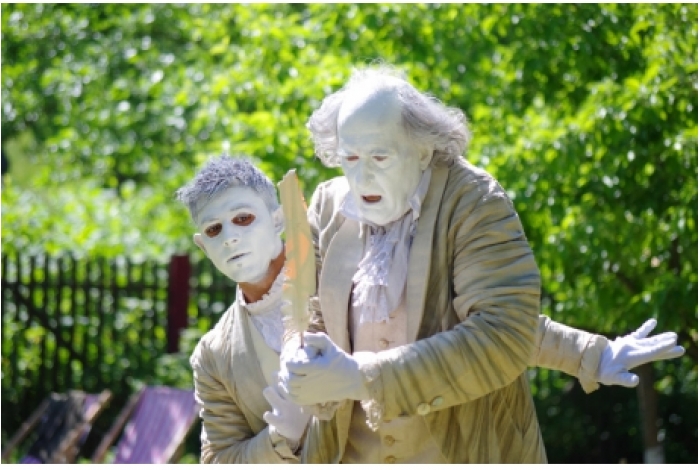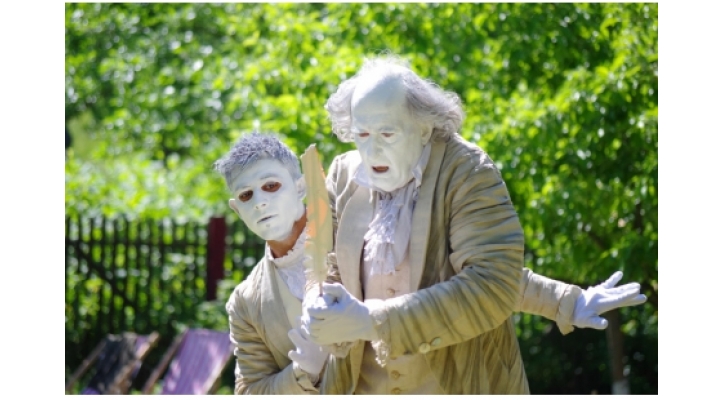Art in the Village of Cata
When we first hit the road to get to the village of Cata, we had absolutely no idea what to expect. We were going to a small village about an hour away from Braşov.

A pantomime performed on the grass
After a drive through the mountains, up and down, we started hitting the smaller cities, places that I had not, until then, ever seen before. These sides of Romania created a very beautiful picture of the national countryside.
Just driving on the small roads, that sometimes turned to gravel, we saw several of small carets and wagons with horses ready to go. In a few places, a small amount of people had set up shops on the side of the road, ready to sell lemonade and water to the passing travelers.
After having driven around for a while, we asked another roadside woman and her friend for directions, and they sent us down a gravely path, that maybe once had been a road. Here, I was certain that we could not get further out in the country. Surely, this was the last village way out here and Cata would be just around the corner.
However, it did take us another 20 minutes through gorgeous plains, framed by the vast Transylvanian mountains. The afternoon sun only made the view even better, lighting up the forest to our right and the fields, cows and horses to our left.
We arrived in Cata at around 5 o’clock. By then many guest had already arrived at Mr. Schuler’s house. Here, we would attend an event he had put together, with guests from Germany, Romania and Luxemburg. This event was created to celebrate Mr. Israel’s Writers Award, prize that would enable him to write about the Transylvanian culture and its people.
The first thing that greeted us when exiting the car, next to a small playground in the tiny village centre, was a group of children playing football and other fun specific outdoor games. The moment we stepped out of the car, they were instantly at the fence looking at us and greeting us curiously, in Romanian. Most of them quickly lost interest when they realized they could not communicate with us, but one boy stayed and asked further questions.
After this warm greeting, we went inside to meet the rest of the guests, where we were encouraged by the host of the weekend, Mr. Schuler, to go meet the people.
And the setting could not be more perfect. Here in Mr. Schuler’s back yard, we saw not only beautiful fruit trees, but also giant posters, in man-size, hanging on the trees and on the walls. On these posters there were poems written both in German and Romanian. Also on the walls there were pictures taken by Mr. Schuler’s son. All around, sitting down on the grass, on the old antique benches and on the patio furniture provided by the host, there were different artists, enjoying the sun and each other’s company. They were sharing their books, their poems, their music and their ideas for future projects, framed by the old buildings, workshops, lanes, cottages and Mr. Schuler’s own private tower, from where you could see almost the entire village.
The first person I spoke to was Jörg Schäffer from Munich. He first met Mr. Schuler back in Germany, through mutual friends and he told me about how he started out as a musician. Being a chemical scientist, he woke one day and asked himself: “I wonder what the O2 – Atom sounds like?”
After calculating his way to a frequency that the human ear can actually hear, he did find the answer. And this specific tune is what set the scene for his future music.
The afternoon and evening quickly passed, with more conversations on the grass and refreshments served by Mr. Schuler’s family.
Dinner was held in the small barn in the corner of the yard, where various speeches were held and more people where introduced. Till midnight you could hear the German and Romanian mixed chatter go on as people got to know each other, and talked about the following day, where they would all perform some sort of artistic show.
After dinner, we walked through the village, which had now gone very dark, towards the house were we would stay for the night. Walking there on the gravel road, with absolutely no people in sight it was easy for our brains to picture an attack, right there on the road, next to an old abandoned factory, where absolutely no one would hear you or see you.
No attackers showed up though and we made it easily to the local bar. Now, this was not just a regular local bar downtown that everyone goes to, this was really THE local bar. You had to know it was there. To go inside, we had to walk through a gate into the private backyard of the family who owned this bar. Right in front of us, there were some chickens wondering around an old rusty car, situated in front of their small, almost falling apart, barn in the back. In the dark, this could seem like a quite scary place. However, to the right we saw the lights and heard the laughter from the small bar, a place that opened when the locals arrived and closed when they were tossed off to bed.
The lady of the house was a proper barkeeper. Very kind and welcoming, strict and selective with the clients who walked in her venue, she immediately invited us on the upper floor of her traditional village house. Inside the small kitchen, the walls where decorated with kitchen appliances I have only seen in Old Danish movies from the 50ies.
Her house was decorated with teddies and pictures for and from her children and nowhere. Absolutely nowhere could we see a computer, or any sort of modern piece of the common current world that we would expect to see in any home. The only thing that she had was a TV in the middle of the living room. That was the place where we spent the night over, looking towards the upcoming interesting day.
In the morning, the neighbor stopped by for a chat, just as we were sitting outside in that same scary courtyard from the night before, drinking coffee and waiting for the rest of the crew to get ready.
After the short walk, back through the village, to Mr. Schuler’s house the festivities started with a few speeches by Mr. Schuler himself, last year’s recipient of the days writers award Elman Schenkel, and this year’s recipient Mr. Israel.
He was handed the cat, which was his trophy, and then there followed more speeches.
After this and a short break where journalists, apart from ourselves had the chance to speak to all of the guests, it was time for the next part of the agenda: A pantomime performed, right there on the grass. Two men dressed and painted completely in white were moving in short burst, very gracefully over the grass, as a tribute to Mr. Israel.
After this, a number of readings where done by different colleges and friends of Mr. Schuler, and again the setting, the sunlit country backyard, filled with writers, musicians and actors, could not be more perfect; the writers in shift read pieces from their newest books.
All the guests were sitting in the grass, next to the reader and were listening intensively to every word about the writer’s thoughts on culture, people and travels in Romania.
The afternoon went on like this. Later on one of the guests took out his guitar and soon we were all singing along to his well-known cover songs. Apparently this man from Germany had his own band back home.
Indeed this day was spent in the spirit of art and music and I cannot think of a better-suited place to host this event, centering on the discovery of Transylvanian culture, than the village of Cata.
Text: Johanna Engebjerg Englev and Kazuki Shimada
Photos: Kazuki Shimada, Adrian Chiriac, Ana A. Negru




